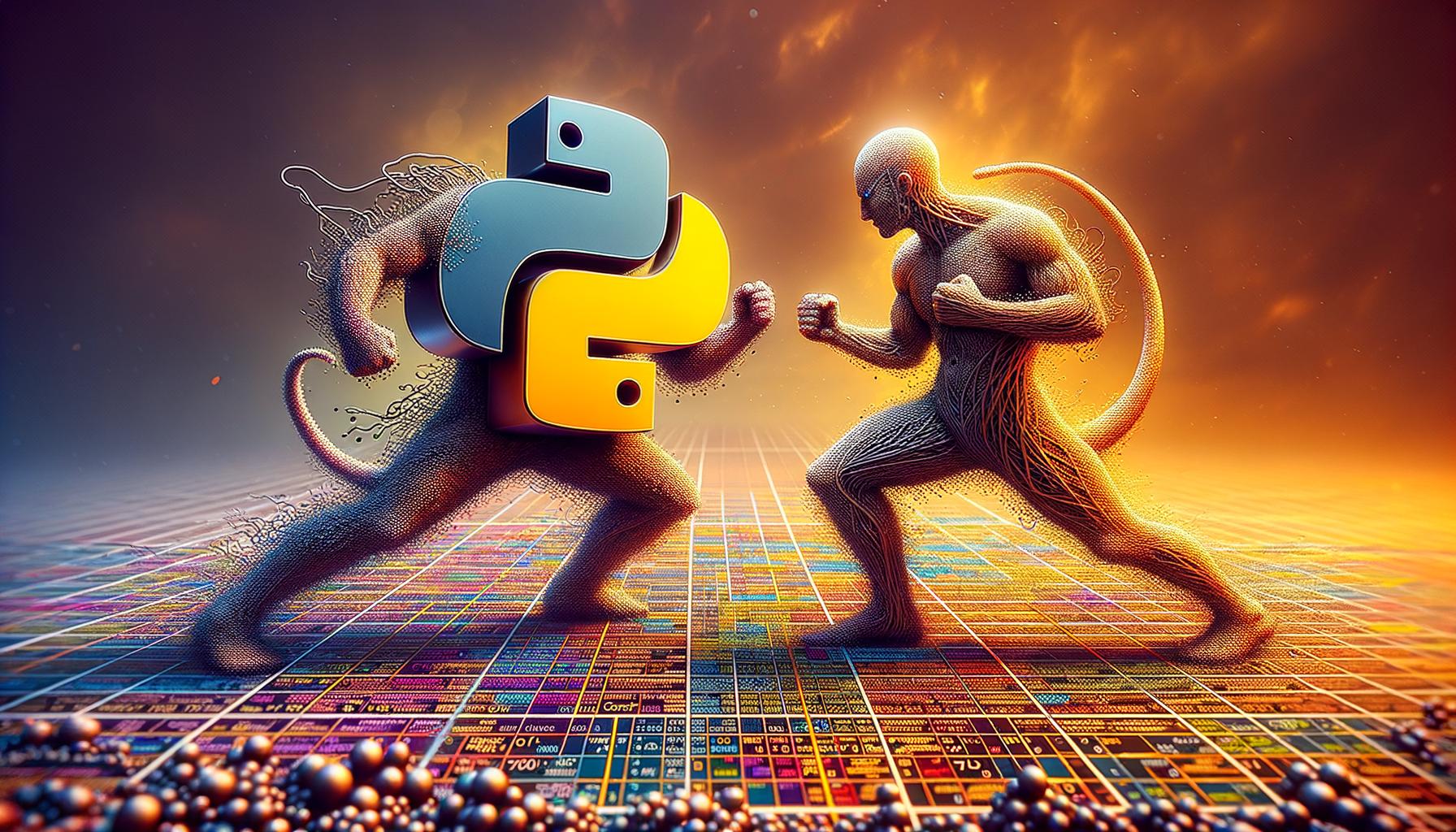Unveiling secrets of R Programming Vs Python: A Comparative Study

As we embark on the thrilling journey through the dense world of programming, two mystery enigmas named R programming and Python emerge as pronounced dialects used by data scientists and enthusiasts worldwide. This extensive exploration will surge forth to analyze the intricacies of both R and Python, often leaving most programmers oscillating between the two. We'll delve into their origins, usage, industry preference, and essential features that make these languages unique and stand taller than the remaining contenders in the vast arena of programming languages. Unraveling the intricacies of these languages becomes essential, as their popularity contest heatedly persists in the coding stratosphere. As we traverse through this maze of "R programming vs Python," we'll delve into the user accessibility of R to the appealing simplicity of Python; from their effectiveness in data cleaning and deep learning capabilities to their integration with other languages. We’ll weigh their pros and cons, study their learning curves, examine the community support, and even forecast their potential future. Our voyage will culminate with insights to help you judiciously select the right tool based on your specific tasks. Get ready to deepen your comprehension of these two programming titans as we begin this comparative odyssey.
Understanding the Basics of R Programming

R programming is a powerful language with roots dating from 1995 when it was developed by Ross Ihaka and Robert Gentleman. Utilized widely across various industries, including finance, healthcare, academia, and technology, it has indeed found favor with data analysts and statisticians due to its extensive array of packages tailored for data manipulation. Born as a statistical programming language, R's industry preference extends to disciplines that necessitate heavy statistical analysis, namely, Econometrics and Biostatistics.
Diving into the features of R, its uniqueness becomes evident in the amount of detail it allows when dealing with data. For instance, R provides excellent graphical facilities, unmatched by other programming languages, which can be highly beneficial for data visualization and corresponding analysis. It also comes built-in with state-of-the-art algorithms for data analysis, allowing for a more complete and complex interrogation of data. As Head of Data Science at Kaggle, Anthony Goldbloom, puts it "R is the best tool for slicing and dicing data to see what's going on." Furthermore, R's open-source status makes it a continually improving platform with regular updates and feature enhancements along with a supportive community continuously contributing to it, indicating that its potential is still far from being fully exploited.
The Essentials of Python Programming

Python programming, well-regarded for its simplicity and versatility, was conceived in the late 1980s and has since gained substantial traction across various industries. The powerful, object-oriented programming language, credited to Guido van Rossum, was specifically designed with readability in mind, making it an increasingly popular choice for beginners to advanced programmers alike. Its widespread utilization is seen across sectors, ranging from web development, to data analysis, machine learning, and beyond.
One of the major strengths of Python is its diverse set of features. In general, Python is highly readable with a clean syntax that favors simplicity over complexity. This fundamentally lends itself to a shorter learning curve, easing the process for novices entering the field. Furthermore, Python is also dynamically typed, bestowing flexibility that allows programmers to make changes on the fly. The ability to write fewer lines of code to achieve the same outcome as more verbose languages ultimately contributes to increased productivity. Certain features like automated memory management, a large standard library, and robust mechanisms for handling exceptions also help set Python apart from other programming languages.
A real-world example of Python's utility can be seen in its implementation by tech giants such as Google, Dropbox, and Instagram. With its powerful capabilities and simple structure, Python continues to be leveraged for building a wide variety of applications. For instance, Google uses Python for its web search system due to the language’s strong internet and web service tools. Additionally, Dropbox utilizes Python to manage most of its user-facing features. The implementation of Python in these instances reinforces the language's robustness and adaptability, solidifying its position as a top pick in programming languages.
R Programming vs Python: The Popularity Contest

When the question arises around the popularity between Python and R programming languages, there seems to be a split consensus. Multiple factors contribute to this split decision. On one hand, we have the rise in popularity of Python over the years, primarily because of its easy-to-use syntax. With Python, beginners can easily grasp programming concepts due to its simple, readable, and well-structured code. It's no surprise then, that according to the TIOBE Index for April 2020, Python stands as the third most popular language in the entire programming world. This brings us to the credible camps of developers who stand by R owing to its application in advanced analytics and data visualizations, domains in which R arguably still holds the edge. It may not be as beginner-friendly as Python, but statisticians, analysts and professional data scientists have a clear leaning towards R, partially due to its extensive package archive for data analysis, CRAN. Hence, defining which programming language is more popular can be subjective and mainly depends on the specific application or task at hand. While Python may lead in general usage, R holds its ground firmly in statistical programming.
Delving into R Programming: User Accessibility

Let's foray into the world of R programming from the perspective of user accessibility. Known for its statistical sophistication, R programming is highly popular among statisticians and data analysts. However, the steep learning curve can make it less user-friendly, especially for novices in the programming world. Often termed an 'inflexible' language, R poses a steep learning curve due to its singular focus on statistical analysis. This is a notable challenge for beginners, but it's not insurmountable. Perseverance and consistent practice can help overcome this initial hurdle, and the payout is valuable. R programming offers powerful statistical analysis capabilities not readily available with other languages.
Moreover, R enables users to delve deep into data analysis without the need for additional packages or tools. However, its command-line interface might be a hurdle for the non-programmer. The sheer amount of detail R provides right from the start can seem daunting. On the flip side, it is this very detail and range of statistical techniques that make R an essential tool in industries like healthcare, where predictive modeling plays a pivotal role in decision making. Ultimately, while R programming might seem intimidating at first glance, the potential unlock once one has gained comfort is invaluable, making R a worthwhile programming language to learn and master.
Exploring Python: Simplicity at its Best
Python shines in the realm of programming due to its simplicity. Often recommended for beginners starting their programming journey, Python offers a clean syntax that is logical and easy to comprehend. It uses straightforward commands in English that learners can quickly grasp, and the language closely imitates how humans actually think. Therefore, this significantly reduces the cognitive overload one often experiences when dealing with complex logic and structure present in many other languages.
Python's utility does not end at its comprehensible syntax; it's also highly preferable as it's forgiving of errors and helps beginners to identify, understand, and fix these mistakes. This is crucial in the learning process, where trial and error is instrumental in understanding how a language works. With Python, learners have the opportunity to experiment and tinker without the fear of debilitating their code irreparably.
However, Python’s simplicity doesn’t mean it’s inept for advanced tasks. On the contrary, many organizations leverage Python to create sophisticated software and carry out complex data analysis tasks. Companies such as Google, Netflix, and Spotify make extensive use of Python, which is indicative of its potential even in highly technical environments. To summarize, Python’s simplicity acts as a stepping stone for beginners and is by no means a limitation to its capabilities when it comes to tackling advanced computational tasks.
Python vs R: The Graphical Analysis Showdown

In the world of data analysis, both Python and R have shown considerable capability when it comes to graphical representation. These two languages have distinct features that make each a viable choice depending on specific use cases. For instance, Python excels with its powerful libraries such as Matplotlib and Seaborn that make complex plots easier to build. On the other hand, R offers a more specialized environment for statistical representation with libraries like ggplot2, enabling creation of fine-tuned plots for more specific analysis.
Python, with its well-structured syntax, is often the go-to choice for general programming tasks that include creating graphics. Moreover, when handling extensive data sets and machine learning projects, Python's versatility allows for sleek data visualizations, making it easier to understand and interpret complex data. The versatility and power of Python’s libraries is a testament to its competence as reflected by its use in real-world applications such as in predictive analytics and deep learning data visualizations.
R, on the other hand, is specifically tailored for statistical analysis, making it a preferred tool for statisticians. R comes with an array of packages that excel in creating more sophisticated and nuanced graphical representations. For instance, it is an adept tool for genomic data visualization as seen in Bioconductor, a project that provides tools for the analysis and comprehension of high-throughput genomic data.
Despite these strengths, it’s important to remember there is no one-size-fits-all approach in choosing between Python and R for graphical analysis. The superiority of one over the other largely depends on the specifics of the task at hand. At times, Python’s general-purpose profile, rich ecosystem and ease-of-use make it a preferred choice. However, on other occasions, R’s tailored statistical infrastructure and nuanced graphic capabilities makes it more suitable for specialized tasks.
In conclusion, both Python and R bring their unique strengths to the table when it comes to graphical analysis. The choice between the two depends largely on the specific task, the complexity of the data, and the desired type of representation. Both languages are powerful tools in the right hands and in the appropriate scenario.
R and Python: Effectiveness in Data Cleaning
Exploring the effectiveness of both R and Python in data cleaning reveals various strengths and nuances. R and Python have distinct advantages in specific scenarios, but their utility largely depends on the complexity of the data in question.
On one hand, Python stands out due to its simplicity and intuitive syntax. Its libraries like Pandas make data cleaning easier, even for complex datasets. For example, functions such as dropna(), fillna(), and replace() enable streamlined handling of missing data. Furthermore, Python's compatibility with machine learning makes it a go-to choice for tasks that involve preliminary data cleaning for predictive modeling.
However, R's dedicated packages like dplyr and tidyr offer a robust set of tools for data cleaning. These packages provide an extensive set of functions to manipulate and transform data, such as arrange(), select(), and mutate(). For instance, a data scientist working with statistical analysis might favor R for its ease in handling and cleaning categorical data.
Nonetheless, while both Python and R offer effective data cleaning capabilities, their ease of use can vary significantly. Python, with its clear syntax and comprehensive libraries, often seems more straightforward, especially for beginners. Contrastingly, R might appear more complex, yet its robust functionality can be powerful when mastered, making it a favored choice among statisticians.
Thus, the choice of language for data cleaning boils down to the nature of the project, the complexity of the data, and the skill level of the user. While Python may provide a smoother experience for novice programmers, R can leverage its robust statistical tools for complex cleaning tasks.
Machine Learning: R or Python?

It's crucial to note that both Python and R have their distinct roles when it comes to machine learning. For instance, R's capacity to handle statistical data analysis, which is integral to machine learning, is highly acclaimed. Meanwhile, Python, with its simplicity and powerful libraries such as TensorFlow and Keras, makes it undoubtedly a contender in the machine learning domain.
However, it's not a cut-and-dried decision when choosing between Python and R for machine learning tasks. One is required to assess the situation at hand while correlating with the kind of Machine Learning Libraries and tools provided by each language. In other words, choosing the preferable language largely depends on the requirements of the project at hand, personal expertise, and the domain of the data being used.
For instance, when it comes to the availability and extensiveness of machine learning libraries, Python certainly takes the upper hand. The Python ecosystem boasts of extensive machine learning libraries like Scikit-learn, TensorFlow, and PyTorch that tremendously ease the tasks of model development and training for machine learning.
On the other hand, the R community has been making consistent efforts in catching up to Python in terms of machine learning libraries. Packages like Caret, mlr, and Rattle, though not as prolific as their Python counterparts, offer a sophisticated suite of tools for varied machine learning tasks.
Ultimately, the conclusion to the "Python Vs R for Machine Learning" debate hugely depends on the developer's proficiency in either language, the sector of application, and the nature of the task. Indeed, Python and R are both powerful languages, and the decision to use one over the other should be dictated by the specific requirements of the machine learning task rather than a blind adherence to language popularity.
Python and R in Data Science: Who Wins?

When comparing Python and R in data science, certain factors can tip the scale. Python's robust ecosystem is packed with libraries and modules that make data manipulation, cleaning, and visual visualization relatively uncomplicated. This, combined with its readability and simplicity, makes Python a darling to both novices and experienced data scientists. For instance, its dominant library ‘Pandas’ provides high-performance, easy-to-use data structures and data analysis tools that significantly simplify data processing and analysis, hence, a strong preference in data science.
On the other hand, R was designed by statisticians for statisticians. Therefore, it provides an exceptional programming environment for data analysis and graphics. R's compelling packages like 'ggplot2' and 'dplyr' have stood the test of time, making the language a strong competitor in statistical modeling and graphics. This statistically oriented language is therefore highly favored in research environments and academia, where deep statistical analysis is required.
Another key determinant to consider when choosing between Python and R for data science is your team's expertise and proficiency in the languages. Some teams prefer R because of its extensive package ecosystem and excellent capacity for data visualization. Conversely, others opt for Python for its simplicity and versatility, making it perfect for developing and shipping production code.
Ease of learning is a vital factor when deciding between Python and R. Python is often recommended to beginners due to its simplicity and human-like syntax, leading to a smoother learning curve. However, a statistician might find R more friendly due to the statistical language commonly applied. Context is therefore critical when considering which language to opt for.
Python’s versatility and easy syntax make it a favorite in industries keen on rapid application development and deployment, such as startups. However, R remains more prevalent in sectors dealing with heavy statistical analysis and decision sciences, such as pharmaceuticals. These examples underscore that different scenarios and requirements may inform the choice of using either Python or R in data science.
In conclusion, there's no clear-cut winner in the Python vs. R for data science debate. The right choice depends on one's specific needs and objectives, team expertise, and the nature of the project at hand. For a quantitative strategist, R may be preferred, whereas Python might be preferable for a software engineer or a computer scientist keen on general-purpose programming.
R vs Python: Deep Learning Capabilities

When considering the role of Python and R in deep learning, it is crucial to delve into their respective libraries. Python, for instance, boasts renowned libraries such as TensorFlow and Keras, which facilitate computation and development of deep learning models. This results in Python being one of the more dominant languages in the deep learning realm. Conversely, R, although not as prevalent in deep learning, still makes its mark with packages like MXNet and H2O. These packages, though lesser-known, have proven efficiency in building deep learning models, leading to R becoming an increasingly popular choice in certain scenarios. Therefore, despite Python's wider recognition in this space, one can't overlook R's potential to contribute to the deep learning domain. This verdict, however, is also dependent on the requirements of a particular project and the practitioner's comfort level with the language.
Python and R: Integration with Other Languages

When it comes to blending with other programming languages, Python demonstrates flexibility and impressive integration abilities. Its functionality can be extended with the use of C, C++, or Java, and it's capable of scripting language to bind together system components. For instance, coding in C can be performed directly in Python using Cython, a form of static compiler. Thus, it amplifies the convenience of language usage, especially when cross-platform functionality is considered, and promotes compatibility with various tech stacks, whether they be traditional or modern.
Similarly, R programming language also shows a considerable degree of integration with other languages. It’s capable of calls to C, C++, and Java. The unique package system in R – known as ‘rJava’ - provides a low-level bridge for Java and R interaction. Moreover, RCPP, another popular package of R, helps integrate R with C++. These features open up gateways for enhanced compatibility with other parts of a tech stack, demonstrating how both R and Python have been developed with a vision to bridge gaps between different technology stacks.
A Look at the Community Support: R and Python
Community support vastly contributes to the success of a programming language, and both Python and R benefit from active, growing communities. Python boasts a large, diverse user base ranging from web developers to data scientists and academia. In contrast, R possesses a more niche community, heavily dominated by statisticians and data scientists. It's interesting to note that both of these communities contribute actively to their respective languages, creating an array of resources and tools for new learners and veterans alike.
The availability of resources and support channels for Python and R is substantial. Python users can access a plethora of tutorials, libraries, and online forums like GitHub and Stack Overflow. R users likewise have an extensive pool of resources and tutorials, with RStudio and CRAN as exemplars. These platforms provide ready-to-use functions and packages, making programming more accessible for users and encouraging interaction.
Problem-solving forums for both R and Python are extensive and dynamic. The Python community on Stack Overflow and GitHub is vast, with problems being quickly solved and questions answered speedily. R users also enjoy an active presence on these forums, where dedicated members offer prompt, reliable assistance when required. This comprehensive community support substantially strengthens the usage and utility of both Python and R.
Performance Showdown: Python vs R Programming

In an intense performance showdown, Python and R emerge as powerful players in programming. A drill-down comparison reveals nuances in their velocity, functionality, and resource exploitation. Python showcases its prowess with faster execution speeds, ideal for time-critical applications. In contrast, R Programming, while not as blisteringly fast, delivers consistent performance, making it suitable for data analysis where speed isn't the absolute priority. As for efficiency, Python astounds with its knack for performing complex tasks with fewer lines of code, optimizing developer time and system resources. Moreover, R's resource consumption tends to be higher, a consideration for programmers working on lower-spec machines. However, R zealously champions data-intensive tasks with its robust package ecosystem. Thus, the performance battle between Python and R Programming hinges not on superiority but on specific use-case requirements.
Where to Use R Programming: The Ideal Use Cases

R programming truly shines in specific domains, standing out as an excellent tool in statistical analysis and data visualization. Known for its robust package ecosystem, it is particularly favored in academia and research environments. For instance, statisticians often prefer it for their analytical work due to the availability of advanced statistical packages such as caret, dplyr, and ggplot2.
Industries that are rich in data and require extensive statistical analysis are prime candidates for using R. These include pharmaceuticals, which often employ R to draw out deeper insights from clinical trial data, and finance, where R is used to model and predict risk and returns. It’s also favored by data scientists and analysts for intricate data mining and manipulation tasks.
Best Scenarios for Python Usage

Python profoundly excels in scenarios involving website development, system administration tasks, and for small-scale data manipulation. As it is highly versatile and easy to use, it has proved to be the preferred choice in industries such as web services and game development. The fact that popular applications like Instagram, Spotify, and YouTube were created using Python is a testament to its credible performance in distinct scenarios.
Furthermore, Python's clean syntax makes it easier for beginners in programming to grasp the language and start actual coding quickly. Coupled with its tremendous library support, which includes packages for practically every function, Python becomes the ideal choice for a substantial number of scenarios, specifically for tasks related to web and app development and script automation.
In the aspect of data analysis, Python's efficient libraries like NumPy and pandas also outperform many languages in terms of data manipulation. This makes Python a go-to language for many researchers and data scientists who frequently work with data in complex scenarios. In this context, Python's ability to perform efficiently across different applications is unmatched.
R and Python: The Pros and Cons Considered
R programming and Python both have their unique strengths and drawbacks. Useful for data analysis and statistics, R shines with its vast library of packages and strong graphical capabilities. Yet, its steep learning curve and less conventional coding syntax can deter beginners. In contrast, Python impresses with its simplicity and universal programming approach. Hailed as the easier language to master, Python also integrates well with other languages. Still, it falters with a less extensive statistical library compared to R. The decision between Python and R heavily rests on the task at hand. Data visualization? Lean towards R. A general-purpose script or integration goal? Python could be your winner.
Choosing the Right Tool: Python or R?

Deciding between Python and R can be influenced by the specific task at hand. As an example, data analysis tasks might tip the balance in favor of R, given its robust package ecosystem. On the contrary, if web app development or system automation is the goal, Python's extensive standard library could make it the preferential choice.
Consideration of the language's community size is also crucial. Python boasts a larger, more global user-base, which can translate to a greater amount of available resources, whether they be online tutorials, coding examples, or peer forums. This does not mean R's community is negligible, just comparatively smaller.
Another influencing factor might be the personal programming background. If the coder has experience in a language stylistically similar to Python, such as Java or JavaScript, they might find Python's syntax more intuitive. For those with a background in languages closer to R, like C or MATLAB, R's syntax could seem more accessible.
Real-life application matters, too. For instance, high-tech industries and startups might have a preference for Python due to its flexibility and ease of integration with other languages. Meanwhile, the healthcare, research or academic sectors might favor R for its strong statical programming capabilities.
The immediate usability is also an essential point to consider. Python is renowned for its readability and simplicity, making it a popular choice for those new to coding. On the other hand, R's steep learning curve might make it less attractive to novices, but its power in handling and analyzing large sets of data is undeniable.
In conclusion, the choice between Python or R often comes down to task specificity, personal preference, community size, and industry application. Some might find Python easier to adopt, while others might find R's capabilities more attractive. Ultimately, you should consider your unique circumstances when deciding which tool to use.
Learning Curve: R Programming vs Python

When comparing the learning experiences of R and Python, Python typically comes out ahead in user friendliness. Its simple syntax and readability give it an edge, especially among beginners. On the other hand, R's steep learning curve may intimidate novices in the programming world.
However, when looking at community support and resource availability, R is by no means in last place. It enjoys robust community support, with a plethora of libraries and a passionate user base ready to help out. Python also has substantial support, coming from its use in a variety of sectors.
Complexity-wise, R caters more to statisticians and data scientists, with more intricate and specialized analysis tools. This complexity can make mastering R a challenging process. Python, meanwhile, offers straightforward and practical tools, simplifying the learning process.
It's important to remember that beginner-friendliness doesn't equate to overall superiority. Python's simplicity might charm a new programmer, but R's sophisticated capabilities deserve recognition.
Lastly, the right tool depends not just on the task but also the learner's patience, goals, and commitment. Both R and Python have unique strengths that justify their place in the world of programming.
Conclusion: The Future of R and Python Programming
Pondering over the future of R and Python, we delve into what trends in programming languages have to tell us. The dynamic nature of programming ushers both R and Python towards a promising future. These languages continue to adapt, grow, and rise to the challenges of modern computing.
Decoding language trends not only validates the importance of R and Python but also hints at their future iterations. The role of each within the sphere of data science and machine learning will continue to evolve.
Python's simplicity and adaptability appear likely to win over novices, fuelling a future of Python-enabled quick programming. On the other hand, R, with its robustness in statistical analysis and visualization, is poised to still retain its reign.
In an era of constant change, R and Python seem committed to maintaining their relevance. The future shines bright as these languages continue to iterate and transform, expanding their capabilities, and catering better to computing needs.
Although both R and Python will continue to thrive, their respective realms may well change. The future will see these languages converging and diverging in different aspects, enhancing their utility in distinct scopes.
Despite these speculations, the future for each language remains incredibly open, driven by user needs and industry demands. The evolution of R and Python is undoubtedly a captivating journey to follow along.
